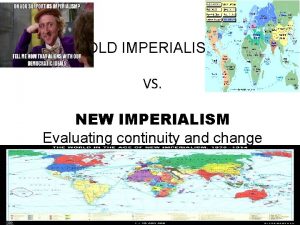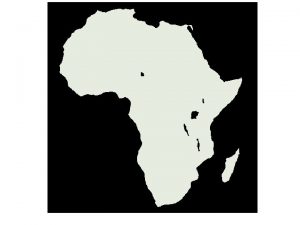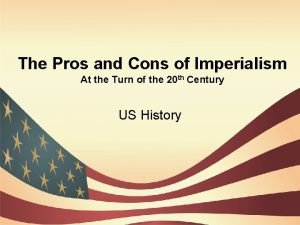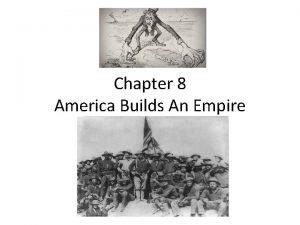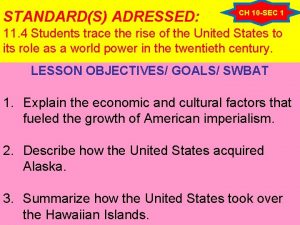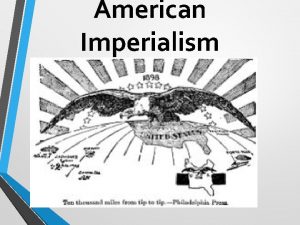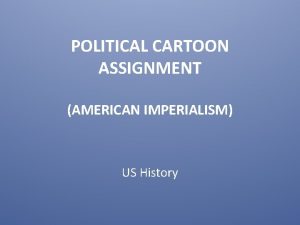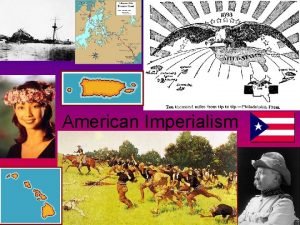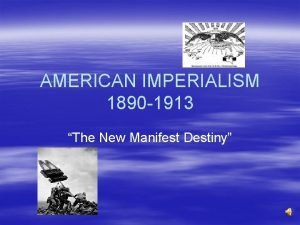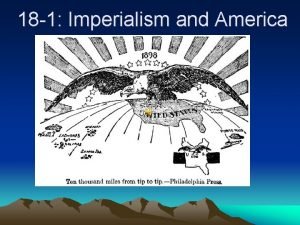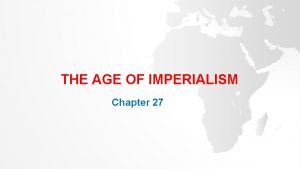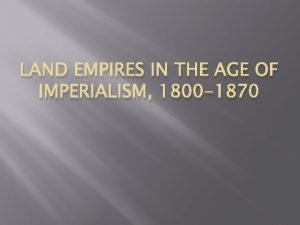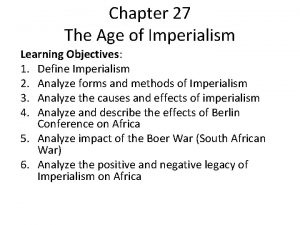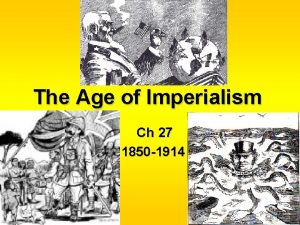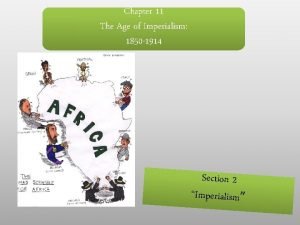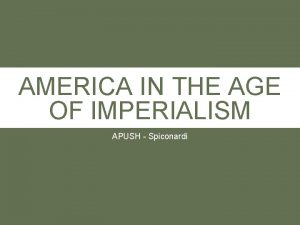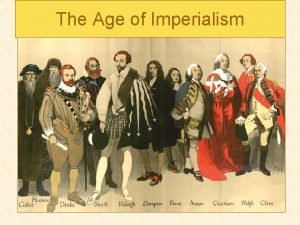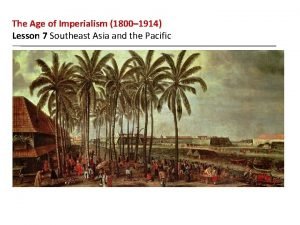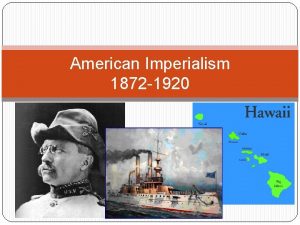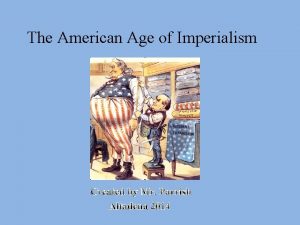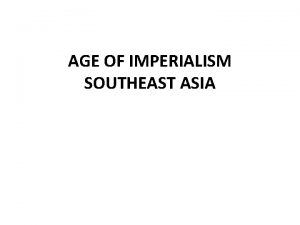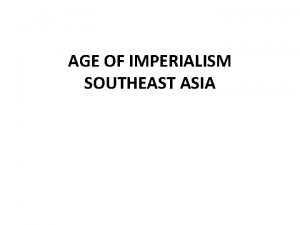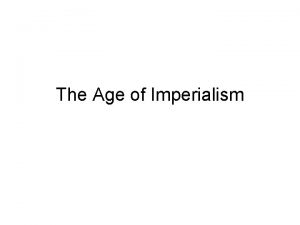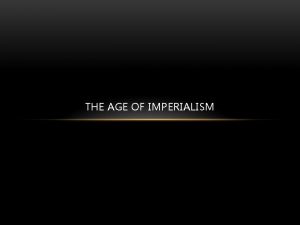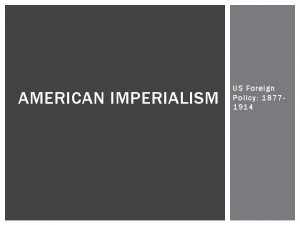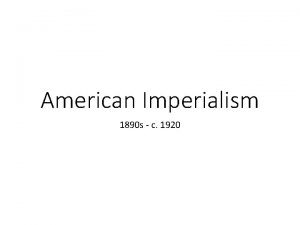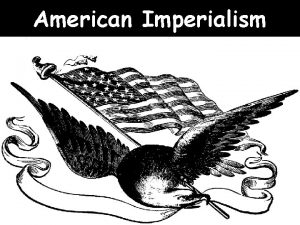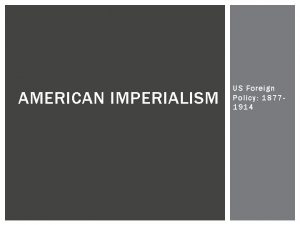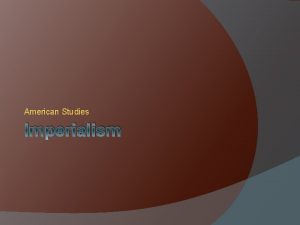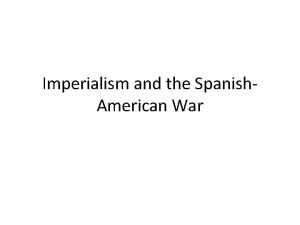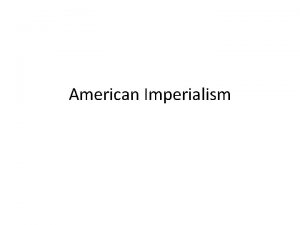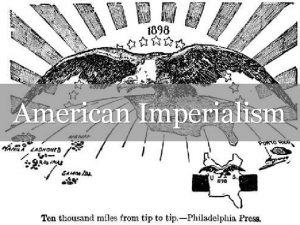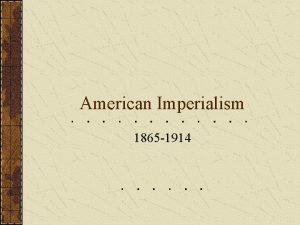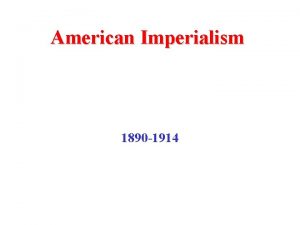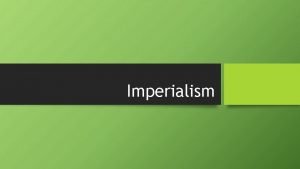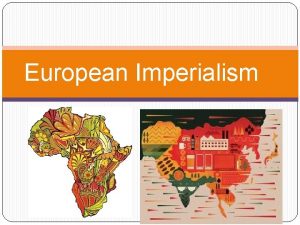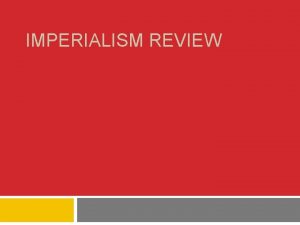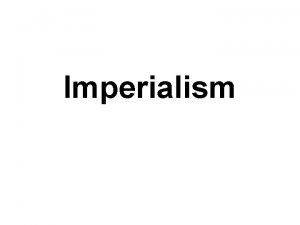The American Age of Imperialism Age of Imperialism






























- Slides: 30

The American Age of Imperialism

Age of Imperialism 1870 - 1914 Imperialism : Strong countries attempt to control smaller and weaker countries or regions Example: Great Britain colonized India as well as up to 80% of the world! Main reasons for imperialism: ECONOMIC $$$$$$ SPREAD RELIGION AND CULTURE TO NEW AREAS COMPETITION BETWEEN EUROPEAN NATIONS

Alaska • Purchased from Russia in 1867 • Known as “Seward’s Folly” (Sec. of State) • Wouldn’t be annexed as U. S. territory until 1884

Hawaii Why did we want it? Rich soils and great weather for growing Military and trade outpost for U. S. A. Sugar Plantations (sugarcane) • From 1830 s, Americans advised the Hawaiian rulers • By Mid 1800 s, American SUGAR plantations were established. They needed cheap labor, so they imported 1000 s from Japan, China, Korea, etc. • 1887: American Planters force Hawaiian King to accept new constitution

Hawaii (cont. ) 1891: King Dies; Sister takes over ; Queen Liliuokalani; she rejects new constitution and tries to restore independence 1893: Planters revolt against Queen; American Troops are sent from U. S. When U. S. Navy arrives, Queen Liliuokalani gives up and the islands are soon a possession of the U. S. 1898: Hawaii becomes a territory of the U. S. A. 1959: Hawaii become the 50 th state of the United States

SPANISH – AMERICAN WAR SPAIN: Once was a massive empire but by 1890, the empire had shrunk to just a few islands Two islands close to the U. S CUBA And two islands in the Pacific Puerto Rico The Philippines and Guam

SPANISH – AMERICAN WAR CUBA In 1895, CUBANS rebelled against the Spanish. They wanted their independence! Nickname : “The Butcher” In response to the Cuban Rebellion, Spain will send a new Governor Named General Weyler

Spanish-American War General Weyler § Used brutal methods to crush the revolt § Moved peasant families into one town for detention § Over 100, 000 died in detention camps § Many starved or died of disease “The Butcher”

Spanish-American War American Reaction § Americans were split on whether to get involved § Newspapers like The WORLD and The JOURNAL used y e l l o w j o u r n a l i s m to increase sales of their papers § The newspapers made Spain look like Villians ! § The U. S. tried to remain neutral PULITZER The World HEARST The Journal

Spanish-American War § BATTLESHIP U. S. S. MAINE In 1898, the U. S. S. Maine was sent to Cuba to protect and evacuate American citizens in Cuba (Havana) • While moored in Havana’s harbor on the night of Feb. 15, 1898, a large explosion ripped through the ship killing 266 sailors • Immediately blame was cast upon the Spanish with American Newspapers fanning the flames of fury.

Spanish-American War § BATTLESHIP U. S. S. MAINE The mysterious destruction of the U. S. S. Maine created war fever for Americans with help from sensational headlines in the newspapers § “Remember the Maine!” becomes one of the battle cries. § Soon after President Mc. Kinley calls for 125, 000 volunteers

War is Declared • On April 25, 1898, two days after Spain declared war on the United States, the U. S. Declares war on Spain • Thousands will volunteer to join the fight, including Teddy Roosevelt and his Rough Riders The Rough Riders

Spanish – American War • The Spanish–American war only lasts for four months • The war was fought in two separate battlefronts: Cuba and The Philippines

The Philippines In 1899 they were made up of 7, 100 islands in the Pacific. Had 7. 5 million people who were divided into 43 ethnic groups that spoke 87 different languages and dialects. Many spoke Spanish due to the fact that it had been part of the Spanish Empire for 400 years.

Attack on the Philippines • April 30, 1898: U. S. Pacific fleet enters Manila’s harbor led by Commodore George Dewey. The next day they destroyed entire Spanish fleet. • 10 Spanish ships sunk or run aground.

The Philippines May, 1898: After Commodore Dewey captured Manila Bay he brought the leader of the Filipino resistance movement, Emilio Aguinaldo, back to the Philippines. Emilio Aguinaldo Rebel leader He then waited for the U. S. army to arrive and promised Aguinaldo support.

The Philippines Aguinaldo then lead attacks against the Spanish fort at Manila, surrounding it and cutting it off from water and food supplies. To his disappointment Dewey did not help him and when the U. S. Army arrived it occupied positions adjacent to Aguinaldo’s revolutionary army. Commodore Dewey

The Philippines After the War a controversy raged in the U. S. over whether to annex the Philippines. Some felt uneasy with the idea of controlling overseas territories. Others believed it made the U. S. stronger and also benefited those under colonial rule.

Treaty of Paris 1898 In October of 1898 representatives of the U. S. and Spain sat down in Paris to negotiate a treaty. No representatives from Cuba, Puerto Rico, Guam, or the Philippines were there to help decide their fate. In the end Cuba would become a protectorate, and Puerto Rico, Guam, and the Philippines became territories of the U. S.

Aguinaldo’s Fight for true Independence U. S. Senate annexed the Philippines on Feb. 6, 1899. Emilio Aguinaldo had already set up the Philippine Republic. He warned that he would take military action if the U. S. tried to take control of the Philippines.

The Philippine Insurrection was a War that resisted American occupation. It was a brutal war of massacre and torture, with both U. S. and Filipino forces committing atrocities. More than 20, 000 Filipino rebels, approximately 200, 000 civilians, and 4, 200 Americans die In 1901, U. S. forces captured Aguinaldo.

END OF THE WAR ! On July 4, 1902, President Roosevelt declared that the war was over. Fighting continued until 1907. The war left a bitter taste in Americans’ mouths. Even T. R. would come to admit that the American people were not fit for imperialism. Aguinaldo lived to see independence granted to the Philippines July 4, 1946, He was 77 years old.

The Aftermath of War Cuba In 1900, the Cubans wrote a constitution. Fearful that another country would dominate Cuban affairs, the U. S. Congress insisted that Cubans add provisions known as The Platt Amendment.

The Platt Amendment 1. Cuba could not make a treaty with another country. 2. Let the U. S. Navy buy or rent land for Bases. (Guantanamo Military base or Gitmo) 3. Cuba’s public debt should not exceed its capacity to pay. 4. The U. S. had the right to intervene in order to protect Cuban independence and keep order.

Puerto Rico Eventually Puerto Rico became an incorporated territory, allowing Puerto Ricans to become U. S. citizens and gave them the right to vote on statehood. In 1952 Puerto Rico became a selfgoverning commonwealth of the U. S. They do not have representation in Congress or an electoral vote in presidential elections.

The Monroe Doctrine In the 1820 s, America was growing weary of foreign influence in our western hemisphere. Fearful that Europeans could spark conflict in our region of the world, President Monroe will proclaim the MONROE DOCTRINE! Monroe Doctrine: The Monroe Doctrine was a US foreign policy regarding Latin American countries in 1823. It stated that further efforts by European nations to colonize land or interfere with states in North or South America would be viewed as acts of aggression, requiring U. S. intervention.

Roosevelt Corollary The Roosevelt Corollary is the “natural consequence” to the Monroe Doctrine that was proposed by T. Roosevelt. It stated that the U. S. would act as the “policemen” of the region. In 1928, under President Calvin Coolidge, the "Good Neighbor" policy stated that the U. S. did not have the right to intervene when there was a threat by European powers, reversing the Roosevelt Corollary.

In the late 1800 s, Britain, France, Germany, Russia, and Japan created Spheres of Influence throughout the coastal regions of China. Sphere of Influence: An area, usually around a sea port, where certain nations had special trading privileges. Each nation could set its own trading laws. These Spheres of Influence were like “trade monopolies” preventing open trade with other countries

“OPEN DOOR POLICY” In 1899, America will propose an “Open Door Policy”. This policy was designed to prevent Japan and China from stopping trade altogether. It also allowed all the other counties with Spheres to “Open” trade in any other Sphere.

Boxers and The Boxer Rebellion Many Chinese resented foreigners in their country. In 1899, a secret group called the “fists of righteousness” formed. In 1900, the “boxers” as they were more commonly known, rebelled and killed over 200 foreigners. Foreign countries, including the U. S. , formed an international force that will sail to China and Crush the rebellion.
 Old imperialism vs new imperialism chart
Old imperialism vs new imperialism chart New imperialism motives
New imperialism motives Stone age chronology
Stone age chronology Iron age bronze age stone age timeline
Iron age bronze age stone age timeline Pros and cons of imperialism
Pros and cons of imperialism Chapter 8 american imperialism vocabulary
Chapter 8 american imperialism vocabulary What 3 factors spurred american imperialism
What 3 factors spurred american imperialism What three factors spurred american imperialism
What three factors spurred american imperialism American imperialism political cartoons explained
American imperialism political cartoons explained American imperialism 1800s
American imperialism 1800s Roots of american imperialism
Roots of american imperialism What does this image depict?
What does this image depict? Alaska american imperialism
Alaska american imperialism American imperialism definition
American imperialism definition Economic roots of american imperialism
Economic roots of american imperialism Chapter 27 building vocabulary the age of imperialism
Chapter 27 building vocabulary the age of imperialism Land empires in the age of imperialism
Land empires in the age of imperialism Chapter 27 building vocabulary the age of imperialism
Chapter 27 building vocabulary the age of imperialism Chapter 27 the age of imperialism
Chapter 27 the age of imperialism Chapter 11 the age of imperialism
Chapter 11 the age of imperialism The white man's burden apush
The white man's burden apush Age of imperialism
Age of imperialism Unit 5 lesson 7 the age of imperialism
Unit 5 lesson 7 the age of imperialism Hát kết hợp bộ gõ cơ thể
Hát kết hợp bộ gõ cơ thể Thế nào là mạng điện lắp đặt kiểu nổi
Thế nào là mạng điện lắp đặt kiểu nổi Các loại đột biến cấu trúc nhiễm sắc thể
Các loại đột biến cấu trúc nhiễm sắc thể Thế nào là sự mỏi cơ
Thế nào là sự mỏi cơ Vẽ hình chiếu đứng bằng cạnh của vật thể
Vẽ hình chiếu đứng bằng cạnh của vật thể Phản ứng thế ankan
Phản ứng thế ankan Môn thể thao bắt đầu bằng từ chạy
Môn thể thao bắt đầu bằng từ chạy Chó sói
Chó sói
